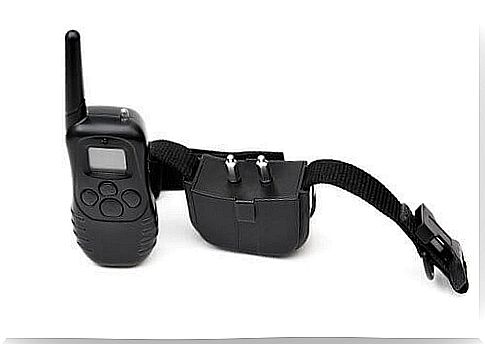When To Use A Bark Collar?

One of the hardest dog habits to bear is barking. Q hen a dog barks a lot, many choose to use an Anti-bark collar.
In this article we explain what the anti-bark collar is and how it works.
What is the anti-bark collar?
An anti-bark collar is a particular collar with a built-in device capable of activating when activity is recorded in the dog’s throat.
The device sends the animal unpleasant stimuli that cause it not to bark. We speak mostly of electric discharges, but also of ultrasounds, vibrations or sprays .
The goal of these collars is to punish the dog when he barks, to be able to distract him from his intentions. The aim is to associate the dog’s desire to bark with the painful stimulus that follows. To avoid the aforementioned stimulus, the animal will remain silent.
This is the theory behind these collars. However, it should not be forgotten how the causes that lead a dog to bark can be various, and not always linked to his will.
The bark is a communicative element, and there are several types of it. Those of emotional origin, for example, cannot be avoided by the dog.
Physical consequences of using anti-bark collars
There are several types of anti-bark collars, each of which has certain consequences for the health of dogs. This type of device is placed on the animal’s throat, one of the most delicate parts.
It is precisely here that the secretory glands of the hormones are found, including the thyroid, as well as some very important nerves directly connected with the spine, consequently with the rest of the body as well as with the brain.
Most of these collars are electric. This means that they send a dose of electrical current through the neck and, consequently, through the main nerves of the body.
Although the manufacturers assure that it is a very low voltage, it must be emphasized that a punishment, to be defined as such and however slight it may be, always brings pain.

Any tension or pain in the neck affects the rest of the body as it spreads through the spine.
The electrical discharges cause muscle contractions, contractures, neuronal problems, tachycardias and more.
They alter the normal functioning of the lymphatic system, the circulatory system and can alter the metabolism, which is in close contact with the thyroid.
Collars that emit ultrasound affect hearing and can cause tinnitus, a condition that is very difficult to diagnose in animals. Beyond that, they affect balance and orientation, and can cause physical pain and profound malaise.
Spray devices, on the other hand, spray their components directly into the dog’s nasal passages. When the most important sense for dogs, namely the sense of smell, comes into contact with aggressive products such as lemongrass, they risk losing sensitivity or suffering damage to the odor glands.
These agents can cause pain, inability to communicate through smell, itching and damage to the mucous membranes (dryness or excessive mucus).
Altering a dog’s sense of smell is the worst damage that can be inflicted on it ; it’s about his way of knowing the world and relating to other dogs.
The sense of smell is essential for his physical and mental well-being.
Further consequences
The use of these devices has been shown to cause continuous stress in the dog.
Stress brings with it an increase in cortisol levels in the blood, which leads to bad mood, inability to rest, irritability and digestive problems (vomiting or diarrhea for no apparent reason).
Among other things, a state of general excitement leads the animal to lose self-control, worsening its behavior.
Psychological consequences of using an anti-bark collar
Collars of this type have not only physical but also psychological consequences. On dogs, prolonged use of punishment not only does not work, it ends up worsening behavioral problems.
No-bark collars, electric or any other type, emit an unpleasant stimulus when the dog uses his throat.
The dog does not understand where the stimulus is coming from, as it comes from the neck and the animal cannot therefore see it.

In addition, the collar is also likely to activate in case of involuntary barking or other sounds (snorts, grunts). When this happens, not only cannot the dog prevent the negative stimulus, but he will not be able to understand the cause.
All of this translates into fears, insecurity and stress. Stressed dogs have worse behaviors than non-stressed dogs.
Precisely for this reason, collars of this type end up not only aggravating existing problems, but even creating new ones. Insecurity breeds dogs with unpredictable and unknown responses.
Fear in dogs is the main cause of aggression and, consequently, of attacks and bites. Faced with a painful stimulus that can be avoided, dogs prefer to flee.
Yet, since they do not know what it is to cause them pain, their reaction is vented on those around them at the moment of the stimulus.
The psychological damage caused by the use of the electric collar, such as insecurity, fear, aggression and all the bad habits that the dog learns during this severe treatment can be irreversible or require a very expensive and complex treatment.
The consequences can last a lifetime.
So when to use an anti-bark collar?
Although the technology of these collars allows to differentiate the power of the stimuli, to make them waterproof or to be used at a distance, no device is able to perceive the cause of the barking in order to avoid them a priori.

There are several types of barks. Some we teach them using the method of positive reinforcement (thus offering a reward for the task performed), others are emotional (caused by stress, pain, joy), others are involuntary.
In the first case, an anti -bark collar cannot work, as it does not recognize the cause of the stimulus: we cannot prevent the dog from barking for what it wants.
Whether it’s to get food, scare the neighbor’s dog or just get our attention.
Even in the second case, the collar does not work, since the dog cannot decide to stop barking.
Emotional behaviors are completely involuntary, just like in the case of a human who starts crying: however much we may be told to stop, we can’t stop.
We cry because we are sad, just as dogs bark based on their emotional state.
The only way to control a dog’s barking is to find the cause and eliminate the stimulus.
An anti-bark collar is not designed for this purpose, and therefore cannot in any way represent a solution to the problem.
Furthermore, as we have seen, its use can lead to very serious consequences that can affect the dog for the rest of his life.









